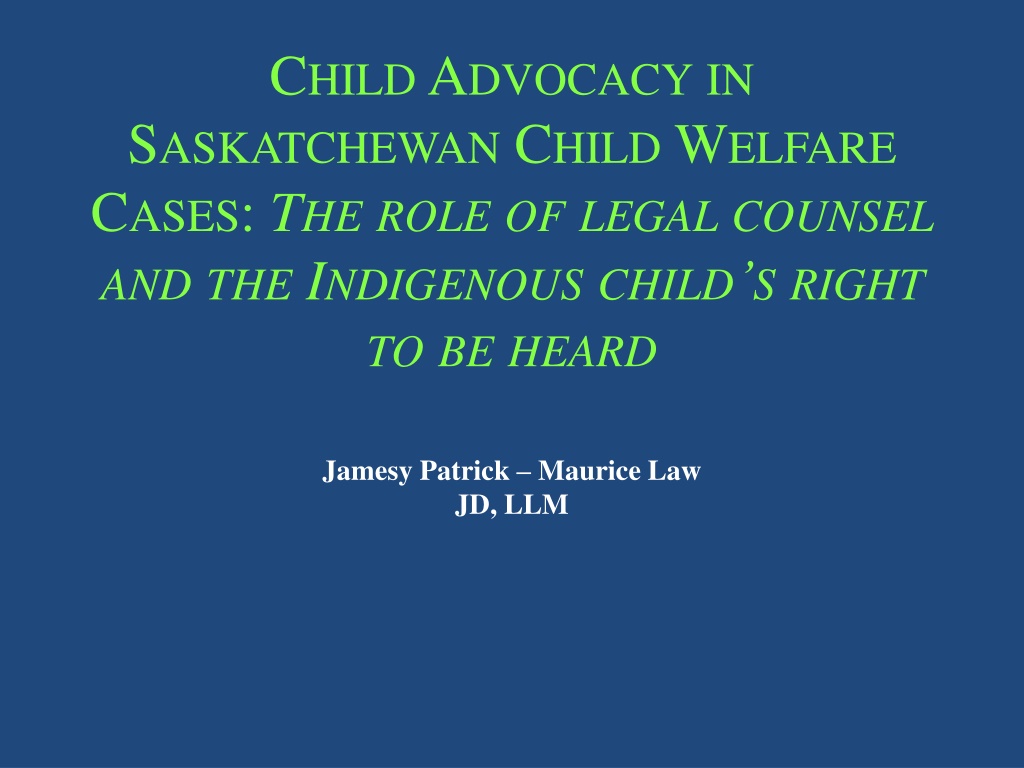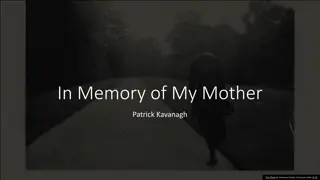Child Advocacy in Saskatchewan: Legal Counsel & Indigenous Rights
An in-depth study explores the United Nations Convention on the Rights of the Child's implementation in Saskatchewan and its impact on Indigenous youth in the child welfare system. It delves into the historical context, current landscape, and challenges faced, emphasizing the need for effective advocacy and legal representation for Indigenous children.
Download Presentation

Please find below an Image/Link to download the presentation.
The content on the website is provided AS IS for your information and personal use only. It may not be sold, licensed, or shared on other websites without obtaining consent from the author. Download presentation by click this link. If you encounter any issues during the download, it is possible that the publisher has removed the file from their server.
E N D
Presentation Transcript
CHILDADVOCACY IN SASKATCHEWAN CHILD WELFARE CASES: THE ROLE OF LEGAL COUNSEL AND THE INDIGENOUS CHILD S RIGHT TO BE HEARD Jamesy Patrick Maurice Law JD, LLM
Background LLM Research Representing Children and Youth, in Saskatchewan Child Welfare Cases.
Research Question Set out to examine the status of implementation of the United Nations Convention on the Rights of the Child (CRC) in Saskatchewan and impacts on Indigenous children subject to the child welfare system.
Presentation Outline 1. The Status of Child Welfare in Saskatchewan 2. Understanding Children s Rights: Different Rights Models (Individual and Collective Rights) 3. Advocacy in Saskatchewan & CRC Implementation 4. Limitations/Recommendations
Approach Case law, literature and legislation. Interviews of persons employed in the child welfare context were undertaken. FNCFSA (17 provincially) Counsel for Children and Youth Program Lawyers
1. Status of Child Welfare in SK We have a sanitized history in Canada, and it has not been like that for Indigenous people at all . So when you have five or six generations of the total institution of the residential schools then we have a context that is more understandable as to why there are community and family issues layered overtop of that is a euro-Canadian child welfare system which is a total failure on all counts. Raven Sinclair Associate Professor, Faculty of Social Work. University of Regina, June 2016.
Saskatchewans Landscape 30% of the Saskatchewan child population is Indigenous. *80% of children in - care in Saskatchewan are Indigenous. Lack of consistent data. *PSI Orders as a mechanism for improving statistics in Saskatchewan Transparency International accountability and reporting (Children s Advocate) Saskatchewan Advocate, transparency with provinces/territories.
1980s An overwhelming dissatisfaction of provincially operated child welfare agencies. Need for First Nations to regain autonomy over Indigenous children and their welfare. First Nations communities began entering into Agreements under the provisions set out in section 61 of the Child and Family Services Act (CFSA). FNCFSA could carry out provincial provision identified in the CFSA (full/partial delegation) Limited control was placed back into the hands of the community to administer all or part of the CFSA as articulated by the province. BUT... BUT...
Funding The inequality of funding started off at 22%, then it went up to 38%, and now it is at 41% - the gap is widening. Director, FNCFSA Human Rights Decision (Family Caring Society) Cindy Blackstock still advocating on this issue. Failure to implement Jordan s Principle Policy to create better shared responsibility on implementation between FNCFSA and MSS.
The answer is not to remove the child from the family, It breaks down creator s laws, grandfathers law, grandmothers laws, and traditional laws specific to families and breaks down tribal affiliation. They come and force these laws upon us. I was traditionally adopted by my grandparents. I was the oldest of the cousins, and one reason for doing that was so that the traditional knowledge could be passed down. Then the Ministry came and said that they [my grandparents] were too old, and I was adopted out at 11 years old...my mom was not consulted, and there you have it, I ended up in Calgary then ran away when I was 17 and then caught the tail end of residential schools. FNCFSA Executive Director
2: Understanding Childrens Rights: Different Rights Models Can you have rights at all if you are too young to exercise choice, when others have to enforce your rights for you, when the obligations upon which your most essential rights depend are often vague and ill-defined, and when you are too young to have reciprocal obligations of your own? Brenda Hale, Understanding Children s Rights: Theory and Practice (2006) 44 Family Court Review 350 at 351
UN Convention on the Rights of the Child (CRC) Canada ratified the CRC in 1991 Include participatory and protective rights (Article 3 vs. 12) Article 3.1 Article 3.1 In all actions concerning children, whether undertaken by public In all actions concerning children, whether undertaken by public or private social welfare institutions, courts of law, administrative or private social welfare institutions, courts of law, administrative authorities or legislative bodies, the best interests of the child shall authorities or legislative bodies, the best interests of the child shall be a primary consideration. be a primary consideration. Article 12.1 Article 12.1 States Parties shall assure to the child States Parties shall assure to the child who is capable of forming his or her own views his or her own views the right to express those views freely in all the right to express those views freely in all matters affecting the child, the views of the child being given due matters affecting the child, the views of the child being given due weight in accordance with the age and maturity of the child. weight in accordance with the age and maturity of the child. who is capable of forming
CRC Implementation Not law Blame for non-incorporation as a symptom of federalism. In child welfare cases in Saskatchewan the courts have not challenged cases where it has been argued that independent counsel be appointed for a child or youth. However, the availability for child counsel in all cases directly involving a child is not guaranteed Private Law Context Counsel more easily available in Saskatoon/Regina Focus on individual rights For Indigenous children, access to voice is further limited. Lawyer- Saskatoon
Indigenous Voice and Childrens Rights - Collective rights theory and individual rights theory Reconciling individual rights and communal rights Racine v Woods Winnipeg (Child and Family Services) v. M.A. Re R.T. et al. Hamilton Health Sciences Corp. v. D.H.
BEST INTEREST This is a case about an aboriginal child who is being denied her right to a permanent, secure family because the aboriginal agency and the band s community committee have vetoed any such placement. The reason for the veto arises from a desire to stop the removal of aboriginal children from their cultural heritage. While a laudable goal, its dogmatic application is counterproductive and unfair. The tragedy in this case is that the best plan for the child, which would see her placed with a permanent family, has been rejected for historical and political reasons that have nothing to do with her case. The irony is that, in trying to make up for past wrongs to aboriginal children and past discrimination towards the aboriginal community, more wrongs are being committed and the discrimination against individual aboriginal children goes on in another form, this time perpetuated by the aboriginal agency and the band community committee. While non-aboriginal children are offered a permanent adoptive family, aboriginal children continue to be offered the lesser option of a foster family, which lacks the permanence and security that would come with an adoption. Winnipeg Child and Family Services v. MA (2002)-
Individual Rights and concepts of the individual have the potential to supersede culture, identity, and community in child welfare cases in SK. Suggests that, failure to incorporate the CRC has the greatest impact on Indigenous children.
3.Child Advocacy Models in Saskatchewan. Provincial Programs: Counsel for Children Saskatchewan Children s Advocate (not at the table in a MSS case) LAWYER AS ADVOCATE
REPRESENTATIONAL Models REPRESENTATIONAL Models Instructional Advocate Instructional Advocate model intended to be adopted in Saskatchewan adopted in Saskatchewan Amicus curiae Amicus curiae Best Best- -Interests Advocate Interests Advocate model intended to be
I just dont know how anyone could just walk onto a reserve, and meet with a kid and adequately represent their wishes in a court room. Lawyer
Lawyer as Advocate Western-European framework - Lawyers have assumed the role of Advocate for children. What about Indigenous Child s voice and access to meaningful voice? Risks of the best-interests model as it relates to Indigenous children. Independent agencies (Saskatchewan Advocate & Counsel for Children) mandate promote children s voice reference to the CRC training that is received access to services lawyer bias
Challenges with Best Interests When we look at what is in the best interest of the child. You can t just say, what is in the best interest of this child only, you have to look at the context of their family their extended family and their community. In looking at this whole advocacy thing - children advocates then look at what they believe is in the best interest of that child, based on their understanding of the world. Director of FNCFSA.
Developing the CFC Program in SK They knew enough not to oppose because of the Convention, that says that this is a right that kids have. So then the government created the program. But there wasn t any consultation. There was not even consultation with lawyers who were doing the work. Lawyer
Summary Divergent perspectives on children s rights (communal & individual rights) Effective implementation of the CRC and Article 12 The child s voice Models of advocating Concerns with lawyer as advocate/best interests Jurisdiction Solutions?
4. Limitations Not focused on one particular community context specific. M tis children/ Non- status Supports needed to foster better understanding of what is meant by best interest
We have developed our own legislation and it is premised on the spirit of the child being the voice of the child . every year I ask for forgiveness from the creator through ceremony, because this job forces me to break our laws. FNCFSA
Some Recommendations The federal government works with and supports FNCFSA in the development of federal legislation/programs that enable FNCFSA and M tis people to govern their own process in partnership with provincial policy and programming. The MSS find better ways to notify any Indigenous child s community immediately upon apprehension of any Indigenous child. The creation of an Indigenous National Children s Advocate which has jurisdictional oversight of First Nations and M tis child welfare agencies which can ensure that FNCFSA mandates, policies and legislation are being conformed with.
A commitment from the federal government and provinces that the Convention on the Rights of the Child be explicitly legislated for under both provincial and federal legislation involving children. Meaningful voice for First Nations children not be limited to the use of a lawyer in child welfare matters. Lawyers advocating for Indigenous children have adequate training and build relationships with Indigenous communities before advocating at the direction of community.
Thank you! Questions & Comments























